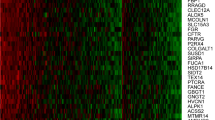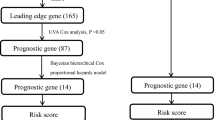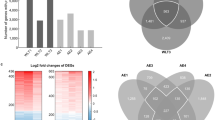Abstract
We have performed oligonucleotide array analysis on various murine lung tissues [normal lungs, lung adenomas, and lung adenocarcinomas (ACs)] using Affymetrix U74Av2 GeneChips to examine the complex genetic changes occurring during lung carcinogenesis. Analysis yielded 20 novel genes differentially expressed in both lung adenomas and ACs versus normal lungs, including the tumor suppressor APC2 and the oncogene Ros 1. In addition, 50 genes were found to be differentially expressed in lung adenomas versus lung ACs, including the differentiation factor Hox C6, the oncogene Ets 2, and the Ras nuclear transport factor, nuclear transport factor 2. To understand the potential relationship between genes expressed in murine lung tumors and its relationship to altered gene expression observed during embryogenesis and postnatal development, tissues from embryonic lungs and from lungs of mice up to 4 weeks following birth were examined using Affymetrix U74Av2 GeneChips. From this analysis, approximately 1300 genes were determined to exhibit differential expression in fetal lung versus postnatal lung. When we compared lung adenomas, lung ACs, and normal lung parenchyma, 24 developmentally regulated genes were found aberrantly expressed in lung tumors; these included the cell cycle control factor CDC5, the cellular differentiation factor TEA domain 4, and the proapoptotic factor BNIP 2. Finally, we compared the murine lung tumor gene expression data to the expression of genes in human lung cancer, in order to assess the relevance of murine lung cancer models in the study of human AC formation. When the 17 human lung ACs and six human lung large cell carcinomas were examined, it was found that 13 of the 17 human lung ACs clustered tightly together in a pattern that was different from the remaining four human lung ACs and six large cell carcinomas, which exhibited a different pattern. Interestingly, the mouse lung adenomas appeared similar to 13 clustered ACs, while mouse lung ACs appeared more similar in pattern to the group consisting of four ACs and six large-cell carcinomas (LCCs). Nevertheless, when compared with the combined human ACs, 39 genes with similar expression changes in murine lung tumors and human ACs/LCCs were identified, such as the oncogene-related BCL7B, the cell cycle regulator CDK4, and the proapoptotic Endophilin B1. Overall, we have determined, for the first time, the expression profiles during murine lung tumor progression and have established, at the molecular level, an association between murine lung tumorigenesis and lung development. We have also attempted to compare the expression profiles found in mouse lung cancers and those in human lung ACs.
This is a preview of subscription content, access via your institution
Access options
Subscribe to this journal
Receive 50 print issues and online access
$259.00 per year
only $5.18 per issue
Buy this article
- Purchase on Springer Link
- Instant access to full article PDF
Prices may be subject to local taxes which are calculated during checkout




Similar content being viewed by others

References
Bonner AE, Lemon W and You M . (2003). J. Med. Genet., 40, 408–417.
Chen J, Yu L, Li D, Gao Q, Wang J, Huang X, Bi G, Wu H and Zhao S . (2003). Gene, 302, 103–113.
Dragani TA, Manenti G and Pierotti MA . (1995). Adv. Cancer Res., 67, 83–112.
Eisen MB, Spellman PT, Brown PO and Botstein D . (1998). Proc. Natl. Acad. Sci. USA, 95, 14863–14868.
Jemal A, Thomas A, Murray T and Thun M . (2002). CA Cancer J. Clin., 52, 23–47.
Li C and Wong WH . (2001). Proc. Natl. Acad. Sci. USA, 98, 31–36.
Lockhart DJ, Dong H, Byrne MC, Follettie MT, Gallo MV, Chee MS, Mittmann M, Wang C, Kobayashi M, Horton H and Brown EL . (1996). Nat. Biotechnol., 14, 1675–1680.
Malkinson AM . (1992). Cancer Res., 52, 2670–2676.
Miura K, Bowman ED, Simon R, Peng AC, Robles AI, Jones RT, Katagiri T, He P, Mizukami H, Charboneau L, Kikuchi T, Liotta LA, Nakamura Y and Harris CC . (2002). Cancer Res., 62, 3244–3250.
Sonnenberg E, Godecke A, Walter B, Bladt F and Birchmeier C . (1991). EMBO J., 10, 3693–3702.
Travis WD, Colvy TV, Corrin B, Shimosato Y and Brambilla E . (1999). World Health Organization International Histological Classification of Tumours, 3rd edn. Springer: Berlin.
Virtanen C, Ishikawa Y, Honjoh D, Kimura M, Shimane M, Miyoshi T, Nomura H and Jones MH . (2002). Proc. Natl. Acad. Sci. USA, 99, 12357–12362.
Wodicka L, Dong H, Mittmann M, Ho MH and Lockhart DJ . (1997). Nat. Biotechnol., 15, 1359–1367.
Wurzer G, Mosgoeller W, Chabicovsky M, Cerni C and Wesierska-Gadek J . (2001). J. Cell. Biochem. Suppl., 36, 1–11.
You M, Wang Y, Stoner GD, You L, Maronpot RR, Reynolds SH and Anderson MW . (1992). Proc. Natl. Acad. Sci. USA, 89, 5804–5808.
Zhang Z, Liu Q, Lantry LE, Wang Y, Kelloff GJ, Anderson MW, Wiseman RW, Lubet RA and You M . (2000). Cancer Res., 60, 901–907.
Acknowledgements
This work was supported by the National Institutes of Health, Grant numbers: R01CA58554 and R01CA78797.
Author information
Authors and Affiliations
Corresponding author
Rights and permissions
About this article
Cite this article
Bonner, A., Lemon, W., Devereux, T. et al. Molecular profiling of mouse lung tumors: association with tumor progression, lung development, and human lung adenocarcinomas. Oncogene 23, 1166–1176 (2004). https://doi.org/10.1038/sj.onc.1207234
Received:
Revised:
Accepted:
Published:
Issue Date:
DOI: https://doi.org/10.1038/sj.onc.1207234
Keywords
This article is cited by
-
Targeting histone methyltransferase G9a inhibits growth and Wnt signaling pathway by epigenetically regulating HP1α and APC2 gene expression in non-small cell lung cancer
Molecular Cancer (2018)
-
Characterizing dynamic regulatory programs in mouse lung development and their potential association with tumourigenesis via miRNA-TF-mRNA circuits
BMC Systems Biology (2013)
-
The Structure and Function of Endophilin Proteins
Cell Biochemistry and Biophysics (2011)
-
An oncogenic KRAS2 expression signature identified by cross-species gene-expression analysis
Nature Genetics (2005)
-
Establishment and characterization of a human large cell lung cancer cell line with neuroendocrine differentiation
Pathology & Oncology Research (2004)


